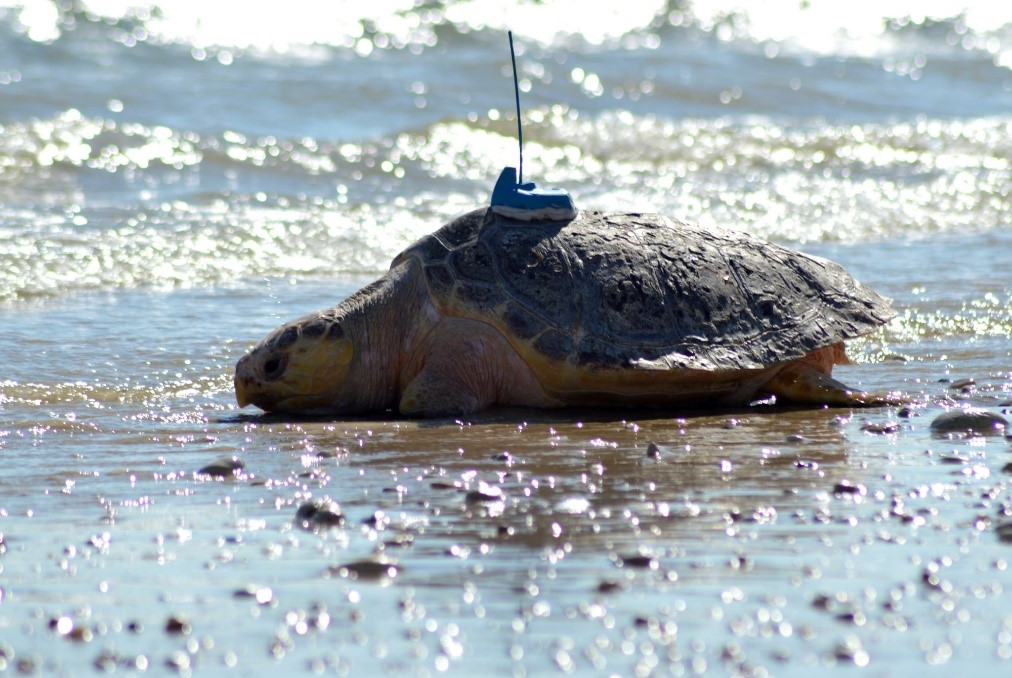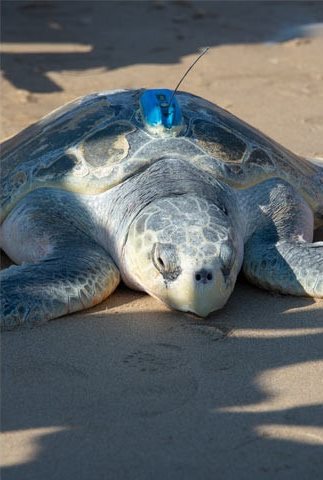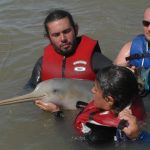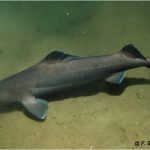← Back
Two very different destinations for two adventurous turtles
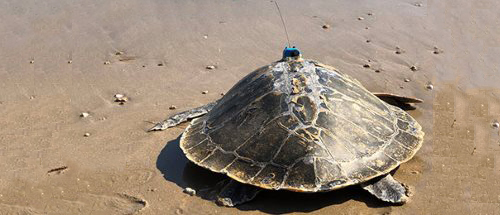
CESTM coordinates the French Eastern Atlantic Marine Turtle Network and welcomes all marine turtles found stranded or in distress drifting or as accidental by-catch along the Channel & Atlantic coasts of France (from the Spanish border to the Belgian border). 220 of the turtles thus cared for have been released since 1988, and 23 were fitted with Argos satellite telemetry PTTs since 2008.
The Argos tracks of the turtles are different each time with a number of surprises. This enable to better understand the behavior of these endangered marine species once released from the French Atlantic coast, and determine what oceanographic parameters influence their movements.
Icare: “Bermuda, here I come!” (or… maybe not)
We already met with Icare a few months ago (see Understanding the tracking of three loggerhead turtles with ocean data). Icare is a young loggerhead turtle found stranded on a beach in Mimizan (South-West of France) in January 2018. This turtle is taken care of by the Centre d’Études et de Soins pour les Tortues Marines (CESTM ; Research and Cares Center for Sea Turtles) of the Aquarium La Rochelle.
The Loggerhead turtle (Caretta caretta) is a vulnerable species, protected at the international level. It lives in every temperate and tropical region of the Atlantic, Pacific, Indian Oceans and Mediterranean Sea, feeding on small fish, mollusks, jellyfish and crustaceans. It’s the only species of sea turtle that nests in temperate zones, every two to three years. Juvenile loggerheads (15 to 24 cm) are frequently stranded during the winter season on the French Atlantic coast because they experience cold-stunning, a debilitating lethargy that often leads to death with a long exposure to cold water. Since 1988, 220 loggerhead turtles have been received care at Aquarium La Rochelle’s CESTM.
Icare was given an Argos PTT just before it was released to the sea from a beach North of the Ré’s island (Charente-Maritime, Western France), equipped by the Centre d’Etudes et de Soins pour les Tortues Marines of the Aquarium La Rochelle. This turtle has now been monitored since June 29, 2018.
Studying his route, the CESTM notes that Icare made a great loop off the Azores archipelago between 24/10/2018 and 22/12/2018. This loggerhead turtle seemed to follow very precisely the boundary between two areas showing steep variations in sea level. These front areas are generally nutrient-rich. Since leaving the Azores area, Icare went a bit South, and made its route towards the Bermuda Islands at about 30°N in a more or less straight line.
Five species of marine turtles have been recorded in the Bermuda Islands. The loggerhead is not known to regularly inhabit the waters of the Bermuda Islands and its nesting activity is extremely rare.
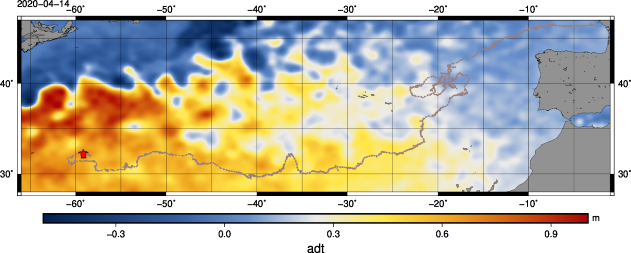
Icare’s track on April 14, 2020 overlaid on Sea Surface Heights (Argos tracks for CESTM/Aquarium La Rochelle, ADT data EU Marine Copernicus). See the Animation of Icare’s track overlaid on Sea Surface Heights (Animation CLS, Argos tracks for CESTM/Aquarium La Rochelle, data EU Marine Copernicus)
So why did Icare go towards Bermuda? These islands are positioned near the Sargasso Sea which offers a unique refuge to a host of open ocean species, including sea turtles. The Sargasso Sea is turning clockwise, driven by the Gulf Stream Current from the northwest and the Canaries Counter Current from the southeast. Icare probably followed the Canaries current and then the North Equatorial current, which reaches close to Bermuda Islands. These days, Icare seems to have had a change of heart, or maybe it is turning around an eddy… According to its capacity, Icare’s PTT will last 920 days. So, we hope to follow its incredible journey until January 2021, and thus learn where it will go. (To be cont’d!)
More info about marine animals tracking
Jupiter may have gone too much North
On December 9 th, 2018, a Kemp’s ridley sea turtle (Lepidochelys kempii) was found grounded on the coast, about 50 km South of La Rochelle. This subadult individual, 56-cm long and weighing 21 kg, was brought to the Centre d’Etudes et de Soins pour les Tortues Marines (CESTM) of Aquarium La Rochelle to be cared for during 7 months. Kemp’s ridley sea turtle is the smallest species of sea turtle (average size at adult stage: 65 cm), in critical danger of extinction according to the IUCN Red List.
Finding a subadult or an adult Kemp’s ridley sea turtle on the Eastern coasts of Atlantic is highly unusual. Most often, turtles of those ages are found within the Gulf of Mexico where they reproduce and where they adopt a mostly coastal behavior. Since CESTM activities began, only 27 Kemp’s ridley sea turtles were cared for, and only 8 of them survived and were released afterwards.
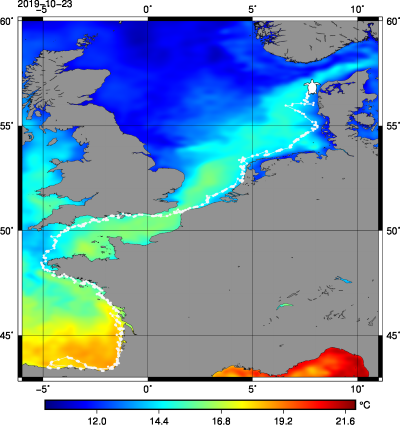
Jupiter’s track on October 23, 2019 overlaid on Sea Surface Temperature (Argos tracks for CESTM/Aquarium La Rochelle, SST data EU Marine Copernicus) See the Animation of Jupiter’s track overlaid on Sea Surface Temperature (Animation CLS, Argos tracks for CESTM/Aquarium La Rochelle, SST data EU Marine Copernicus)
On July 4 th, 2019, this turtle, nicknamed Jupiter was released from the same beach as Icare one year before. It began by swimming South, down to Spain, staying close to the coast all the time, for about three weeks. Then on July 24 th, it began migrating North. It toured the Brittany peninsula, and entered the English Channel in August. It went along both French and English coasts, crossing the Channel twice. Once in the North Sea in late September it went along the Belgian, Dutch, German and Danish coasts. Between October 25th and November 3rd, it was even located in the Skagerrak, the strait between Denmark and Norway. It continued to travel North, but its PTT stopped working at 58.6°N, on November 20th, 2019, after 140 days, nearly 4,000 km and 9 countries crossed.
Our hypothesis is that it followed a « warm » tongue of water that far North. However, when it receded with Autumn, Jupiter did not go back South, while the water temperature dropped to less than 10°C. Then, it’s possible that Jupiter suffered from cold-stunning, this is what happens unfortunately to marine turtles that stay a long period in cold water.
References and links
- Centre d’Études et de Soins pour les Tortues Marines (CESTM) of the Aquarium La Rochelle
- https://www.facebook.com/AquariumLaRochelle/ (in French)
- Argonautica Educational project from CNES enables to follow those turtles (Icare is still ongoing)
Photo : Jupiter on its way to the ocean (Photo Aquarium La Rochelle SAS)

